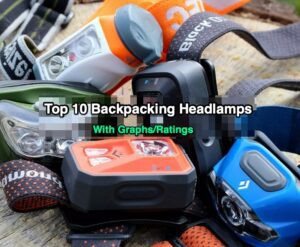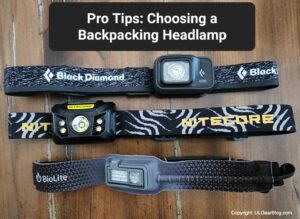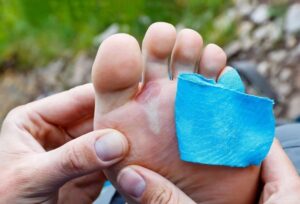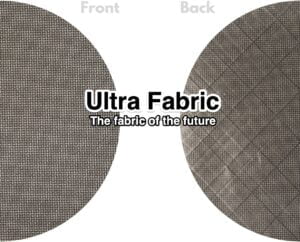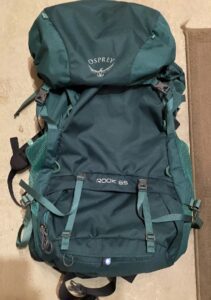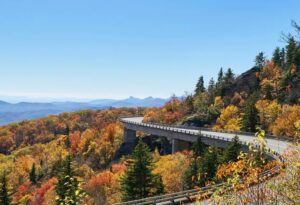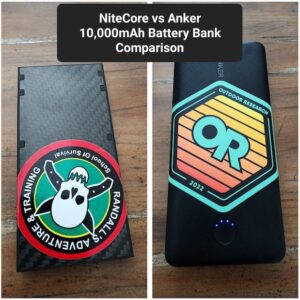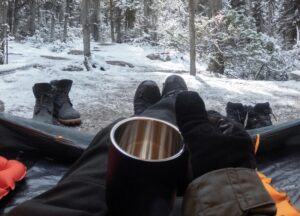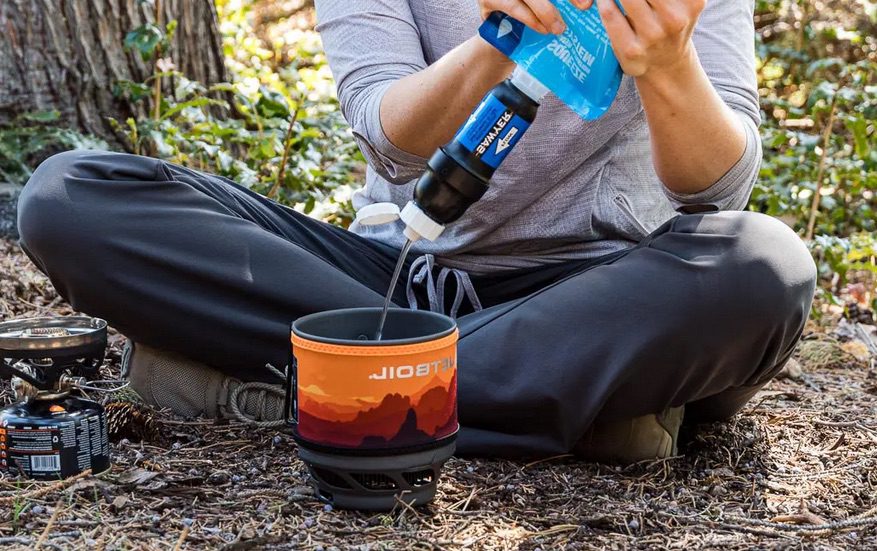
A Review of Water Filtration Systems and Types
When preparing for a backcountry adventure, having access to safe drinking water is absolutely essential. An effective water filtration system serves as the critical backbone for a healthy and successful hiking trip. After extensive research, testing, and using more than 25 different water filtration/filter systems and brands we’ve created this comprehensive guide to help you find the best backpacking water filter for your needs.
Why Water Purification is Vital
When hiking and camping in the backcountry, sources of drinking water are often from lakes, streams, ponds, and other untreated sources that can harbor dangerous pathogens. Consuming contaminated water can make you extremely ill, so having an effective water purification plan is absolutely essential.
Waterborne Pathogens
Untreated backcountry water can contain a variety of undesirable microbes such as:
- Bacteria: E. coli, Salmonella, Campylobacter, Shigella
- Protozoa: Cryptosporidium, Giardia, Entamoeba
- Viruses: Norovirus, Hepatitis A and E
Bacteria and protozoa are larger in size (0.2-100 microns) while viruses are much smaller (0.004-0.1 microns). Filter pore size is important when considering pathogen removal.
Associated Illnesses
Consuming water contaminated with these pathogens can lead to severe diarrheal sickness, intestinal issues, vomiting, nausea, and other unpleasant symptoms. Some of the common waterborne illnesses include:
- Cryptosporidiosis: From the Cryptosporidium protozoa. Diarrhea can last up to 3 weeks.
- Giardiasis: Caused by the Giardia protozoa. Symptoms include abdominal cramps, bloating, and chronic diarrhea.
- E. coli Infection: Bacteria that causes severe stomach cramps, vomiting, and diarrhea.
- Dysentery: Intestinal infection marked by severe diarrhea with blood and mucus.
- Hepatitis A: Caused by the hepatitis A virus. Cause liver infection and jaundice.
Getting sick with these conditions can ruin your backpacking trip. Carrying an effective water filtration system helps provide safe drinking water and minimizes the risks when gathering water from unknown sources.
Water Filtration vs. Purification
Water filters and purifiers both aim to remove pathogens from untreated water sources. However, there are some key differences:
Water Filters: Designed to remove bacteria and protozoa using a porous filter media. They do not remove viruses.
Water Purifiers: Disinfect water by killing or deactivating viruses, bacteria, and protozoa. This is done through filtration combined with chemical treatment, UV light exposure, or other methods.
Filter Pore Size
Filter pore size is measured in microns, referring to the physical gaps that water passes through. Smaller micron ratings trap more pathogens:
- 1 micron: Removes protozoa (Giardia, Cryptosporidium)
- 0.2-0.4 microns: Removes bacteria (E.coli, Salmonella)
- <0.1 microns: Required to remove viruses
Most water filter pore sizes range from 0.2 to 0.4 microns to eliminate bacteria and protozoa. Adding chemical disinfection can help deactivate viruses.
Types of Water Filters and Purifiers
There are several methods and technologies available for filtering and purifying water in the backcountry. Here are some of the most popular options with their pros and cons:
Pump Filters
Pump style water filters are very common among backpackers. They force water through a filter membrane using manual pressure from pumping. Examples include the Katadyn Hiker Pro and MSR MiniWorks EX.
Pros
- Proven reliability
- Can pull water from shallow sources
- Good flow rate
Cons
- Heavier weight
- Require manual effort to operate
Gravity Filters
Gravity filters work by letting water move downward through a filter via gravity, no pumping required. Sawyer Squeeze and Platypus GravityWorks are two top choices.
Pros
- Great for filtering large volumes
- Minimal physical effort
- Simple operation
Cons
- Can be slower flow rate
- Need space to hang and position
Squeeze Filters
These lightweight and packable filters use a flexible pouch and hand pressure to squeeze water through a filter membrane. Popular options are the Sawyer Squeeze and HydroBlu Versa Flow.
Pros
- Very lightweight
- Compact
- Fast and simple
Cons
- Can wear out over time
- Hand fatigue from squeezing
UV Water Purifiers
UV purifiers use ultraviolet light rays to damage the DNA of pathogens, rendering them unable to reproduce or infect. The SteriPEN Adventurer is a top choice.
Pros
- Extremely effective against viruses
- Rapid water disinfection
- Lightweight
Cons
- Requires batteries
- Does not filter out debris or sediment
Other Water Treatment Methods
In addition to water filters and purifiers, some other options for treating water include:
Chemical Disinfection
Treatment drops or tablets like Potable Aqua contain chlorine dioxide to kill microbes. They are affordable and lightweight but take 30-60 minutes to work and can leave an aftertaste.
Boiling
Boiling water vigorously for 1-3 minutes is an effective emergency method to kill bacteria, viruses, and protozoa. But it requires carrying extra stove fuel and is time consuming.
Top 10 Backpacking Water Filters: Specifications, Chart Comparison
Based on in-depth testing and research, we have compiled this list of the top-rated backpacking water filtration systems:
Detailed Comparison Table: Filter Type, Micron Rating, Flow Rate
| Product | Type | Micron Rating | Flow Rate |
|---|---|---|---|
| Sawyer Squeeze | Squeeze | 0.1 microns | 1.8 L/min |
| Platypus GravityWorks | Gravity | 0.2 microns | 1.75 L/min |
| Katadyn BeFree | Squeeze | 0.1 microns | 2 L/min |
| MSR MiniWorks EX | Pump | 0.2 microns | 1 L/min |
| LifeStraw Flex | Squeeze | 0.2 microns | 2 L/min |
| Grayl Ultralight | Pump | 0.1 microns | 0.5 L/min |
| HydroBlu Versa Flow | Squeeze | 0.1 microns | 1 L/min |
| SteriPEN Adventurer | UV Purifier | N/A | 0.5 L/min |
| Katadyn Hiker Pro | Pump | 0.2 microns | 1 L/min |
| Survivor Filter | Straw | 0.05 microns | 200 ml/min |
Detailed Comparison Table: Filter Life, Weight, Dimensions
| Product | Filter Life | Weight | Dimensions |
|---|---|---|---|
| Sawyer Squeeze | 100,000 gallons | 3 oz. | 5 x 5 x 10 in |
| Platypus GravityWorks | 1,500 gallons | 11.5 oz. | 5 x 5 x 9 in |
| Katadyn BeFree | 26,417 gallons | 2.3 oz. | 3.5 x 5.4 in |
| MSR MiniWorks EX | 2,000 gallons | 17 oz. | 7 x 3 x 6 in |
| LifeStraw Flex | 26,417 gallons | 2 oz. | 1 x 5 in |
| Grayl Ultralight | 300 gallons | 15 oz. | 7.87 x 2.95 in |
| HydroBlu Versa Flow | 100,000 gallons | 3 oz. | 1.5 x 5.5 in |
| SteriPEN Adventurer | 3,000 treatments | 5.6 oz. | 1 x 6.5 in |
| Katadyn Hiker Pro | 1,000 gallons | 15.4 oz. | 3 x 11.5 in |
| Survivor Filter | 100,000 L | 3.2 oz. | 7 x 2 in |
Graph Overview of Water Filters Reviewed
Water Filter Flow Rate Comparison Bar Chart
Here’s a bar chart comparing the flow rate of each filter. As we can see, the “Katadyn BeFree” and “LifeStraw Flex” have the highest flow rates, while filters like “SteriPEN Adventurer” and “Grayl Ultralight” have the lowest.
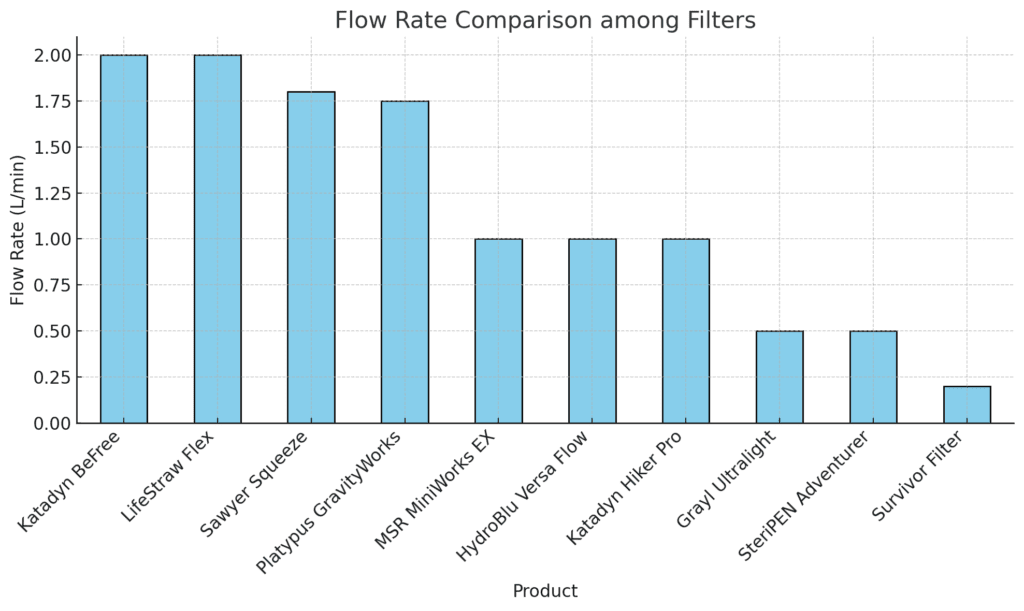
Distribution of Filter Types Compared Pie Chart
Here is a pie chart showing the distribution of filter types. The chart depicts that “Squeeze” type filters are the most common, followed by “Pump” type filters.
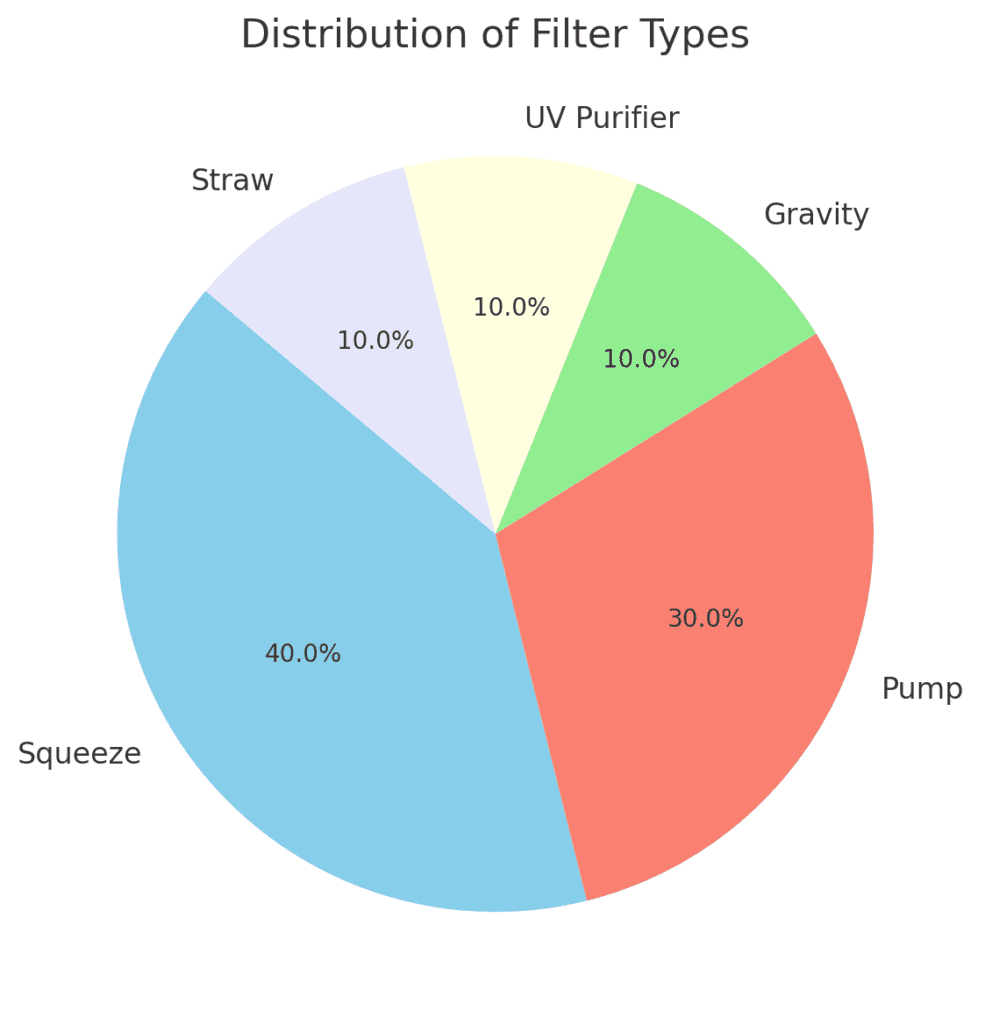
Water Filter Weight Comparison Bar Chart
Here’s the bar chart comparing the weight of each filter. It’s evident from the chart that the “MSR MiniWorks EX” is the heaviest filter, while the “LifeStraw Flex” is the lightest among the ones listed.
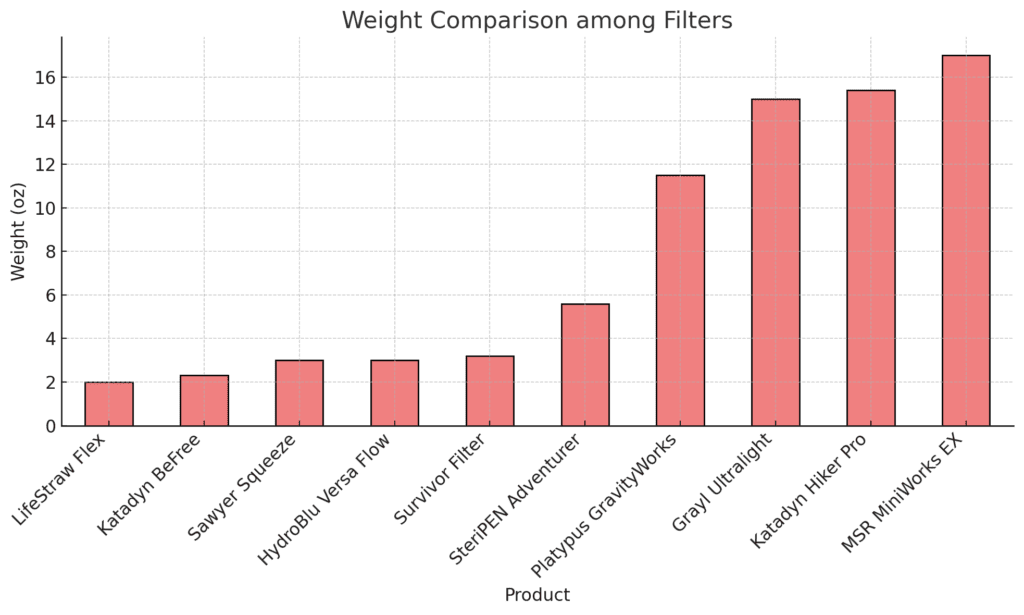
Filter Life Comparison Bar Chart Comparison
We created a horizontal bar chart comparing filter life for each filter we reviewed. This required cleaning the up the “filter life” data, since there are different units (gallons, treatments, and liters) used. For simplicity, we converted everything to liters, since 1 gallon is approximately 3.786 liters. From the chart, we can see that the “Sawyer Squeeze” and “HydroBlu Versa Flow” have a significantly longer filter life when compared to the others.
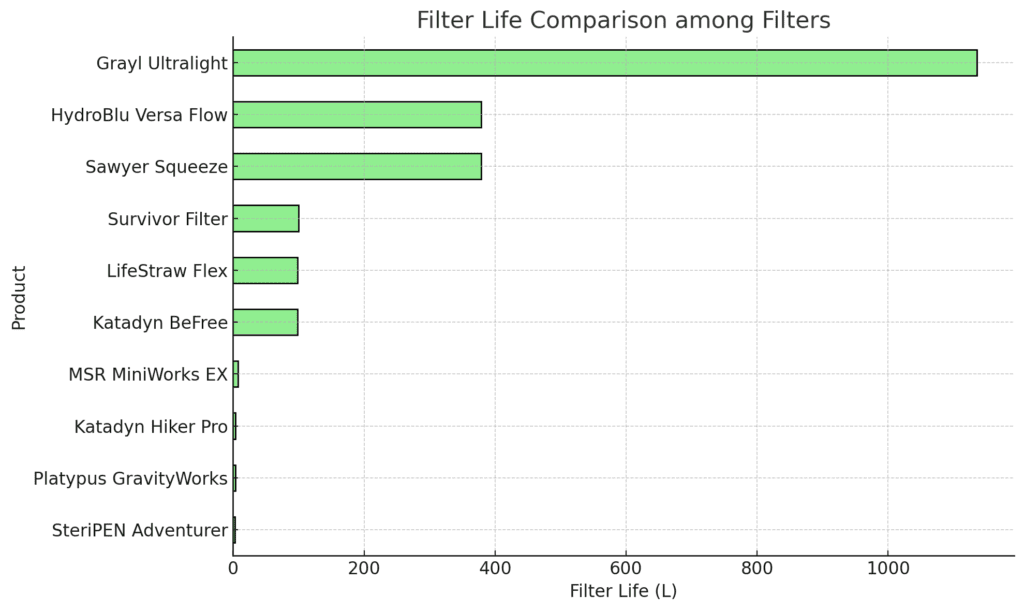
List of All Water Filters Reviewed: Pros, Cons, & Filter Details
Below we’ve listed each of these top-rated water filter options in more detail:
Sawyer Squeeze
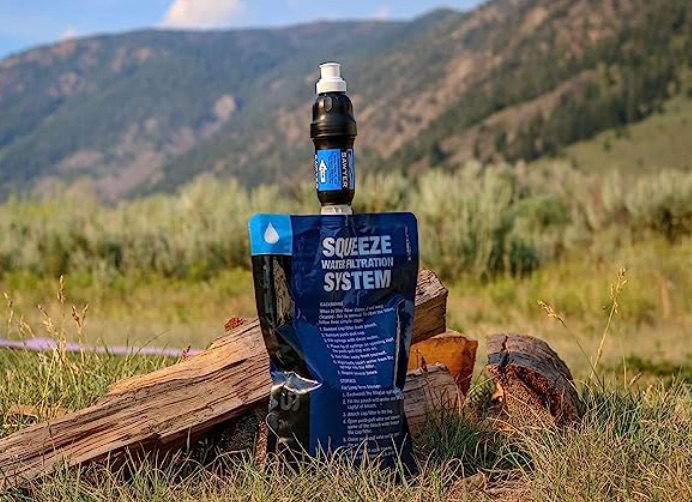
This popular lightweight squeeze system filters up to 100,000 gallons with a 0.1-micron filter. Weighing just 3 oz., it has a fast flow rate of 1.8 liters per minute. The included pouches are also compatible with hydration bladders for on-the-go filtering.
Pros
- Lightweight and compact
- Good balance of flow rate and longevity
- Versatile for multiple water sources
Cons
- Hollow fiber filter can clog more easily
- Requires squeezing effort
Platypus GravityWorks
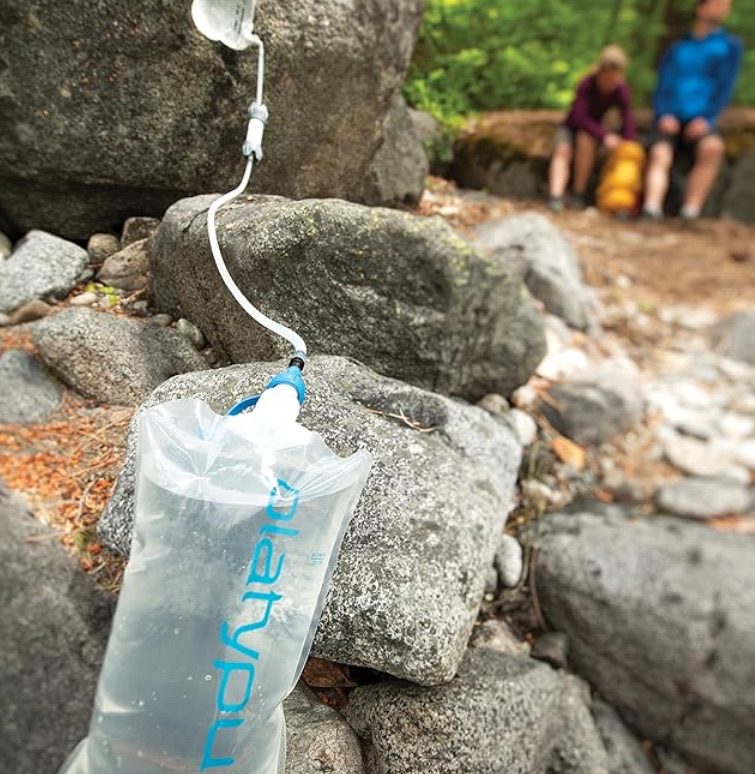
This large capacity gravity system can filter 1.75 liters per minute through a 0.2-micron filter. The reservoir and hose setup allow you to simply fill, hang, and drink right from the hose. The filter cartridge is good for 1,500 gallons.
Pros
- Fast flow rate for the volume
- Convenient gravity-powered filtering
- Huge capacity good for groups
Cons
- Heavy at 11.5 oz. when reservoir is full
- High initial investment
Katadyn BeFree
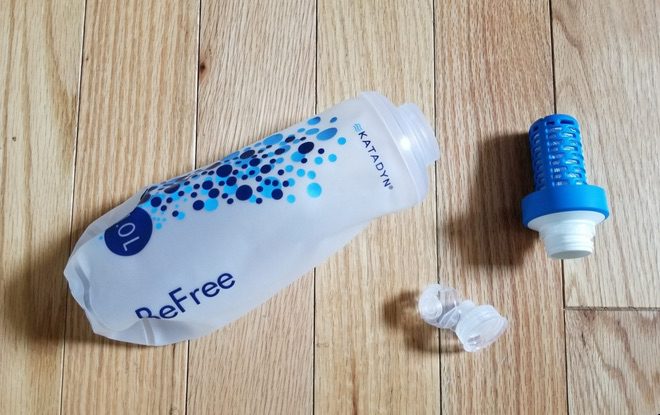
The BeFree is a soft water bottle-style filter with a 0.1-micron filter rated to 26,417 gallons. Flow rate is 2 liters per minute, with a tube included to drink directly from water sources. Weighing just 2.3 oz, it’s ultralight and packable.
Pros
- Lightweight and easy to pack
- Hydration bladder compatible
- Fast flow rate
Cons
- Lower longevity than other models
- Hollow fiber is prone to clogging
MSR MiniWorks EX
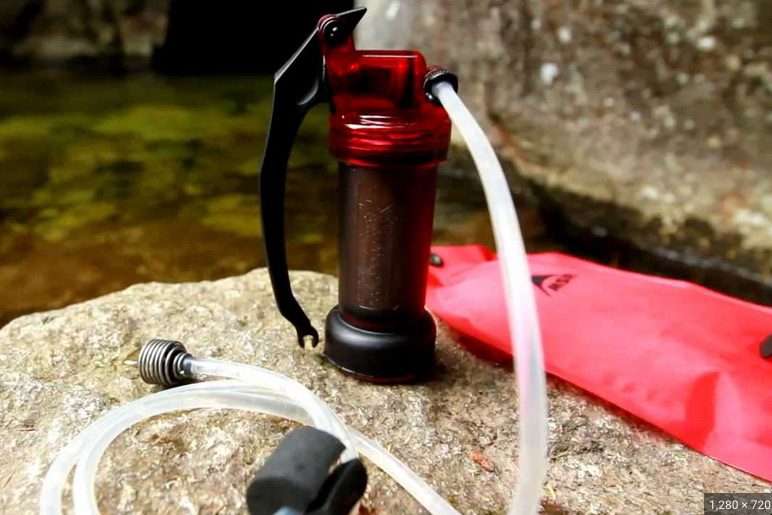
This pump filter system uses a ceramic element and activated carbon to remove protozoa, bacteria, particulates, and improve taste. The 0.2-micron filter lasts for 2,000 gallons with a flow rate around 1 liter per minute. Overall weight is 17 oz.
Pros
- Excellent filtration performance
- Durable ceramic filter medium
- Improves taste by reducing chemicals
Cons
- Heavier than other compact filters
- Requires manual pumping
LifeStraw Flex (w/water bladder)
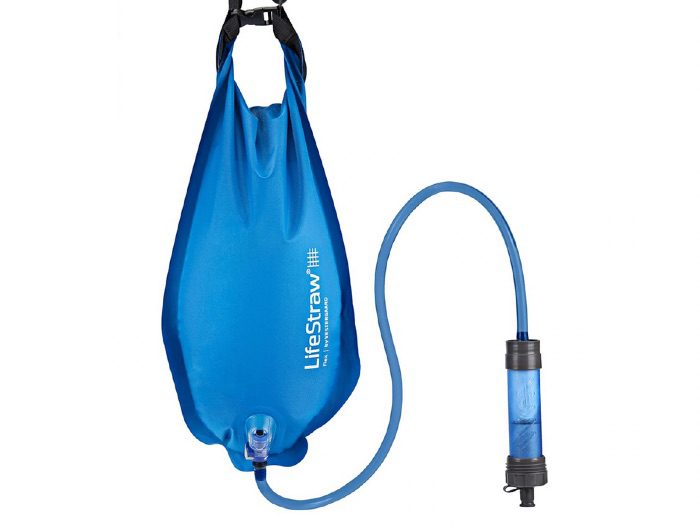
This innovative soft flask style filter with two-stage filtration has a 0.2-micron hollow fiber membrane good for 26,417 gallons. It can filter up to 2 liters per minute and weighs just 2 oz.
Pros
- Ultralight design
- Integrated soft flask for drinking
- Two-stage filtration
Cons
- Lower longevity rating
- Slower flow than similar models
Grayl Ultralight
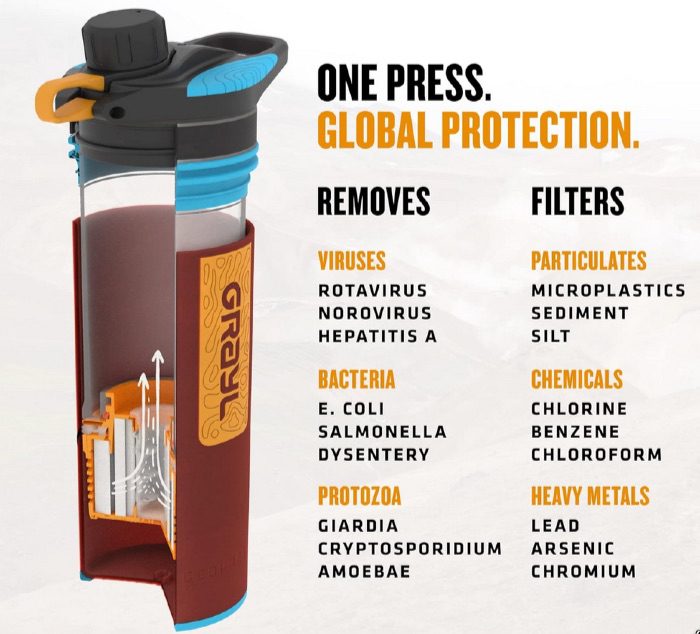
Using a single-button operation, this compact pump style purifier filters 16 oz. per press through a 0.1-micron filter lasting 300 gallons. The whole unit weighs 15 oz. and is an easy to use all-in-one system.
Pros
- Simple and easy to operate
- All-in-one purified water bottle
- Effective filter removes all pathogens
Cons
- Heavy compared to other compact filters
- Low 300 gallon lifespan
HydroBlu Versa Flow
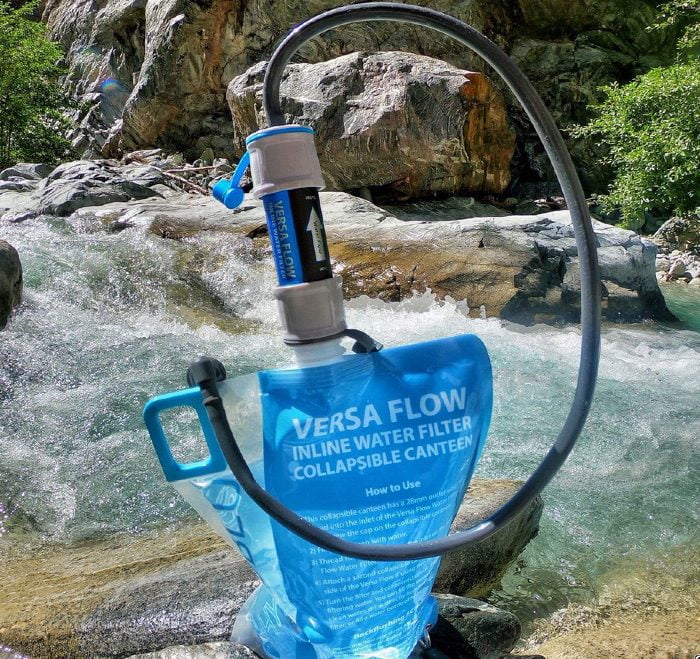
The Versa Flow is an affordable lightweight squeeze-style filter that removes 99.99% of bacteria and 99.9% of protozoa through a 0.1-micron hollow fiber membrane with impressive longevity of 100,000 gallons.
Pros
- Excellent value for performance
- Compatible with standard water bottles
- Light and packable
Cons
- Low flow rate of 1 liter/min
- Requires squeezing
SteriPEN Adventurer
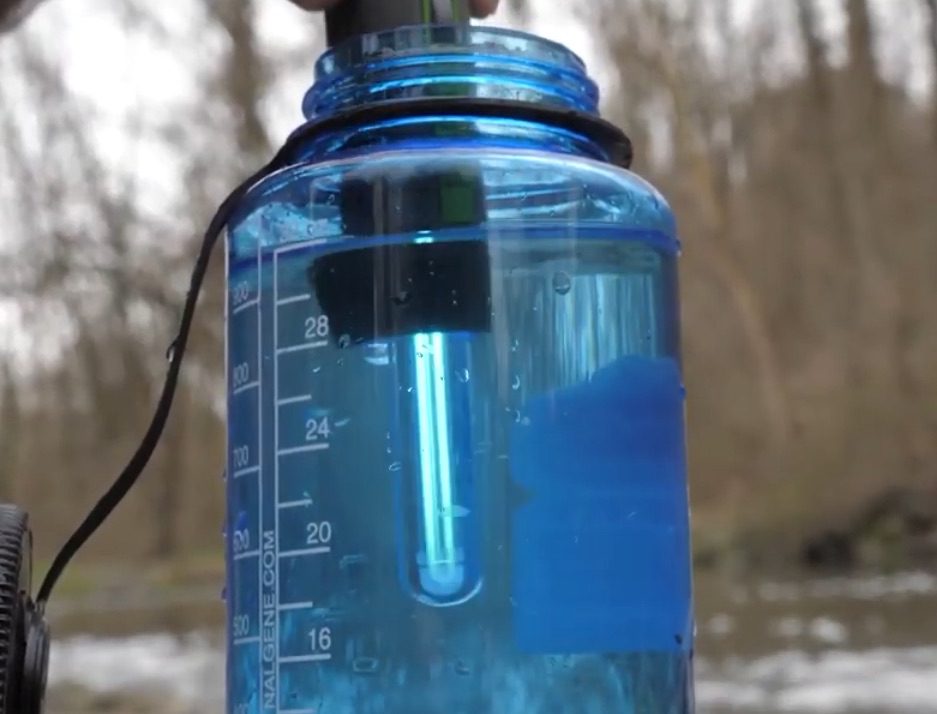
This portable UV water purifier effectively neutralizes viruses, bacteria, and protozoa by damaging their DNA so they cannot reproduce. It treats 0.5 liters in 60 seconds with a rated lifespan of 3,000 treatments.
Pros
- Extremely effective against viruses
- Rapid disinfection
- No chemicals or aftertaste
Cons
- Requires disposable CR123 lithium batteries
- No filtration, only inactivates microbes
Katadyn Hiker Pro
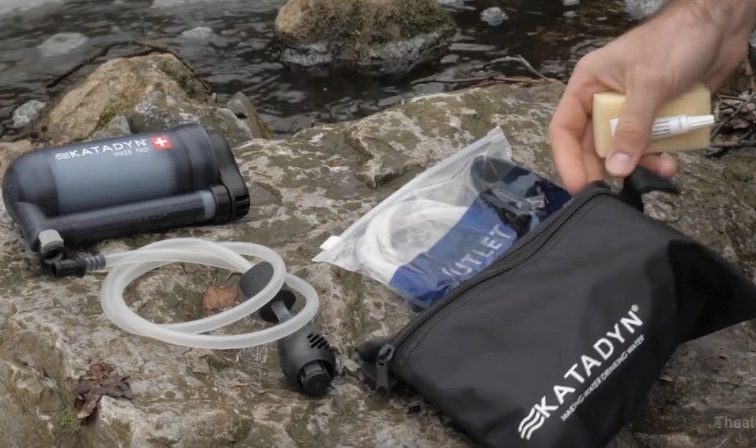
The Hiker Pro pump filter provides 0.2-micron filtration to remove bacteria and protozoa. The glass fiber and activated carbon filter lasts up to 1,000 gallons. It has a flow rate of 1 liter per minute and weighs 15.4 oz.
Pros
- Sturdy and durable construction
- Good balance of weight and longevity
- Filters both protozoa and bacteria
Cons
- Heavier than ultra-compact models
- Manual pumping requires work
Survivor Filter
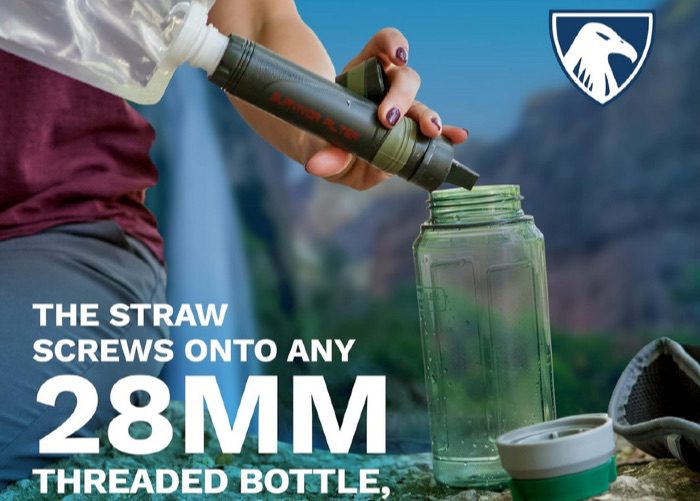
This innovative straw-style filter lets you drink directly from lakes and streams without pumping or squeezing. The 0.05-micron membrane removes bacteria, protozoa, and particulates. It can filter 100,000 liters over its lifespan.
Pros
- Lightweight at 3.2 oz.
- Built-in virustatic to neutralize viruses
- Drinks directly from water sources
Cons
- Slow flow rate of 200 ml/min
- Biting and sucking can be tiring
Factors to Consider When Buying
When selecting the ideal backpacking water filter for your needs, keep the following factors in mind:
- Weight – Important for ultralight backpackers counting every ounce.
- Flow Rate – Faster is better when replenishing water on the go.
- Capacity – The amount filtered before needing replacement.
- Longevity – How many gallons a filter cartridge can process over its lifetime.
- Filtration Performance – Bacteria, protozoa, viruses, particulates removed.
- Treatment Method – Pump, squeeze, gravity, straw, or UV.
- Group Size – Solo use, pairs, or large groups.
- Water Sources – Lakes, streams, shallow puddles.
- Maintenance – Ease of filter cleaning and replacement.
- Freezing – How it performs in below freezing temperatures.
- Budget – Prices range from $20 to $300+.
Prioritize the factors most important for your intended backcountry adventures.
Using Your Water Filter or Purifier
Once you’ve selected the right water filter, it’s key to use and maintain it properly. Here are some tips:
Pre-Filtering Water
- Strain out debris: Use a bandana or cloth to remove sticks, plants, and sediment which can quickly clog filters.
- Let sediment settle: Collect water and let it sit 30-60 minutes so particles settle to the bottom before filtering.
- Pre-filter: On very muddy water, pre-filter through a coffee filter, fabric, or sieve first to prolong the life of your main filter.
Cleaning and Maintenance
- Backflush regularly: Reverse the flow of water to clean out accumulated particles from the filter membrane.
- Scrub thoroughly: Use supplied brushes to scrub clean the filter surface, especially after filtering cloudy or sediment-filled water.
- Dry and store properly: Allow to fully dry between uses and keep in a sealed bag or pot to prevent mold growth in the filter.
- Replace filter elements: Follow manufacturer recommendations for when to replace filter cartridges to ensure optimal contaminant removal.
- Disinfect other parts: Use bleach or other disinfectants to sanitize unfiltered water reservoir bags and drinking tubes.
Frequently Asked Questions
What is the typical filter lifespan or capacity?
Anywhere from 100 gallons for basic straw filters, up to 10,000+ gallons for high-capacity gravity or pump models. Others list capacity in number of treatments.
How long do filters last before needing replacement?
Filter life depends on use frequency and conditions. Most last 1-3 seasons for the average weekend user. Heavily used filters may need yearly replacement.
When is it time to replace my filter?
Replace when flow rate slows significantly, the filter shows damage like cracks or leaks, after the recommended lifespan, or if contaminated water tastes/smells pass through.
How do filters work in freezing temperatures?
Letting filters freeze damages the filter membrane. Keep them insulated and warm or sleep with filter in your sleeping bag at night. Some work better than others in cold conditions.
Can all filters remove viruses?
Most portable filters don’t remove viruses as their pore size is too large. To remove viruses, look for a filter with a 0.1 micron or smaller pore size rating, or a purifier that uses chemical treatment or UV light to deactivate viruses.
What should I do if my filter flow rate seems slow?
Try backflushing to clean the filter membrane. Scrub the inlet side with a brush. If it’s still slow, replace the filter cartridge. A slowed flow rate indicates the filter is clogged.
How do I backflush my water filter?
The process varies, but typically involves filling the outlet side with clean water, then forcing it backwards through the inlet to flush out debris. Refer to the product manual for specific instructions.
What water filter brands are the best?
Top brands include Sawyer, Katadyn, MSR, Platypus, LifeStraw, Grayl. Consider factors like weight, capacity, flow rate, ease of use, and cost to choose what’s best for your needs.
Can I filter salt water or other non-potable water sources?
No, backcountry filters are only meant for filtering fresh water from natural sources like lakes, streams, and rivers. They will not remove salts, heavy metals, and chemicals.
Recommended Accessories
To get the most out of your backpacking water filter, consider pairing it with:
- Collapsible water containers and bladders
- Drinking tubes and straws
- Water bottle adapters and connectors
- Carrying pouches and cases
- Cleaning kits with brushes, scrub pads, and solution
- Replacement filter cartridges
Final Thoughts
Finding the right backpacking water filter ensures you can enjoy drinking from backcountry water sources safely and confidently. Consider your specific needs and backpack style to choose the perfect balance of weight, capacity, ease of use, and reliability. With proper care and maintenance, a quality filter will provide you with healthy, contaminant-free hydration for all your adventures. Stay safe and drink up!
Note: We make a tiny bit of extra money from affiliate links we may add to reviews and other articles. However, we do provide honest reviews, and do not favor certain products over others.
